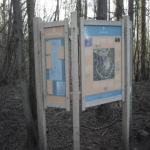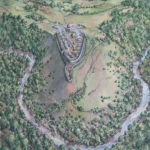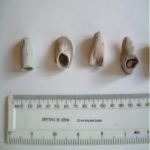Throughout the Nidd Gorge area there is evidence of almost continuous human activity, from pre-history to the 21st century. An archaeological study in 2001 – 2003 traced at least 41 sites of archaeological or historical significance within a square kilometre centred on ‘Gates Hill Camp’, a promontory settlement on the north bank of the Nidd, now partially obscured by a modern housing estate. A former cave to the west of the camp may have been inhabited in earlier pre-history, but the earliest conclusive archaeological evidence (flint tools and polished axe heads) comes from the first farming communities of the Neolithic, dating to c.3, 500 – 2,000 BC. Evidence in the Bronze Age, 2,000 – 600 BC is scant. However, a local place name ‘Howe Hill’ is derived from Old Scandinavian meaning ‘(Place at) the hill or barrow’, suggesting a possible late Neolithic or Bronze Age round barrow burial. A cist (stone-lined grave) containing a skeleton was also uncovered during the building of the nearby Leeds – Thirsk railway in 1849; again suggestive of Bronze Age activity.
Later pre-history and into the historical period (c.600BC onwards) is more widely and substantially represented. Gates Hill Camp itself stands on a promontory settlement 70 metres above the river Nidd. Originally defended in the Iron Age by earth banks and ditches, there are nearby enclosures which may be contemporary.
Roman or Romano-British quern stones for grinding flour and other foodstuffs have been found near Bilton Hall Farm. To date there is no evidence of activity in the Anglo-Saxon period following the collapse of the Roman Empire in Britain.
Gates Hill Camp may have been exploited during the Civil War* as a battery position associated with the siege of Knaresborough Castle in 1644. A warning beacon is recorded here during the Napoleonic War and the site was used for military training during WW1 and WW2.
Coal Pits Wood has the remains of ‘bell pits’ associated with the 18thC Bilton Colliery and possibly earlier workings and the feature ‘Coal Wath’ suggests a river crossing where the fossil fuel was taken north towards the Ripley Road.
The Woodland Trust have commemorated some of these archaeological features by way of Interpretive Panels at Gates Hill and carved oak benches throughout the woodlands of the North bank.
Much research remains to be done and the Bilton Conservation Group welcomes interesting snippets of information which may help build up a more detailed picture of our heritage.
Gallery



